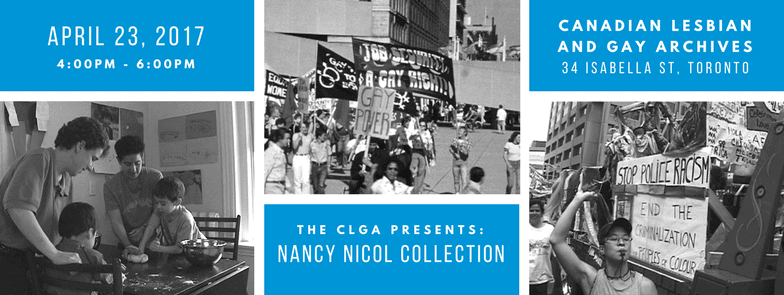[Originally published in The Recipes Project, 28/02/2019. Reproduced by permission of the author]
By Michael Pereira
When it comes to meals, brunch is the queerest of them all. I may not have the empirical evidence to back up this claim, but I would bet that brunch is itself a queer invention. It’s not quite early enough to be breakfast nor does it have the requisite midday feel to be lunch. It’s boldly in-between. It foregoes traditional boundaries and crosses widely agreed upon lines—just like the queer folk among us.
It was clear to me where I needed to look when asked to feature the Canadian Lesbian + Gay Archives’ collection of cookbooks. With heavenly hybrids of breakfast and lunch fare, brunch is the most versatile meal of them all. It’s also a perfect opportunity to pop open your finest (or cheapest—we don’t judge) bottle of champagne before 11am! Catch your local drag queens and kings for drag brunch at a queer-friendly cafe, restaurant, or early-rising bar on a Sunday morning for a different kind of spiritual experience.

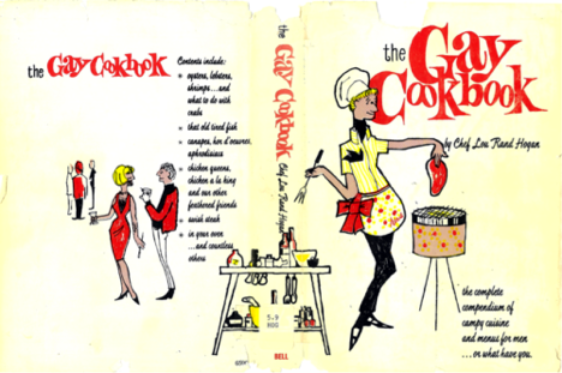
You can find cookbooks that range from informative to campy by a wide range of authors in and out of drag. This includes:
- The Alice B. Toklas Cook Book by Alice B. Toklas (1954)
- The Gay Cookbook by Chef Lou Rand Hogan (1965)
- Be Gay! Eat Gay!: The Gay of Cooking by The Kitchen Fairy (1982)
- La Gay Gourmet by Carl Mueller (1983)
- Out of Our Kitchen Closets: San Francisco Gay Jewish Cooking by Congregation Sha’ar Zahav (1987)
- But Can She Cook? by Christopher North (1993)
- Healthy Eating Makes a Difference: A Food Resource Book for People Living with HIV by Sheila Murphy (1993)
- Cookin’ With Honey: What Literary Lesbians Eat edited by Amy Scholder (1996)
- The Drag Queen’s Cookbook & Guide to Sensible Living by Honey van Campe (1996)

So call up your besties, try-out some of the recipes that follow, and have a gay ol’ time!
“Kaffi’s Corn Bread” from But Can She Cook?
Don’t be afraid to get a little corny for your brunch party! A fabulous line-up of drag queens pose for glamour shots alongside their favourite eats in this cookbook published in support of Casey HouseHospice, established in 1988 as Canada’s first stand-alone hospital for people with HIV/AIDS.
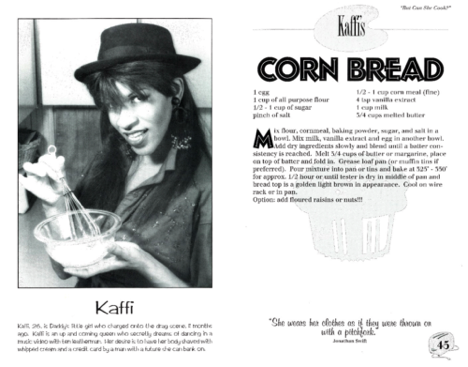
“Oeufs Francis Picabia” from The Alice B. Toklas Cook Book

Alice B. Toklas’ cookbook is a charcuterie board of the who’s who of 20th century art and culture in France. It includes recipes and anecdotes featuring Gertrude Stein, Pablo Picasso, Henri Matisse, and, as the name of this dish suggests, Francis Picabia. “The only painter who ever gave me a recipe was Francis Picabia and though it is only a dish of eggs it merits the name of its creator,” Toklas explains.
Break 8 eggs into a bowl and mix them well with a fork, add salt but no pepper. Pour them into a saucepan—yes, a saucepan, no, not a frying pan. Put the saucepan over a very, very low flame, keep turning the eggs with a fork while very slowly adding in very small quantities 12 lb. butter—not a speck less, rather more if you can bring yourself to it. It should take ½ hour to prepare this dish. The eggs of course are not scrambled but with the butter, no substitute admitted, produce a suave consistency that perhaps only gourmets will appreciate.
The Cooking Fairy’s “Queerberry Crepes” from Be Gay! Eat Gay!
On a cold wintry morning wrap yourself up in the warm, tender love and care of these silky strawberry crepes.
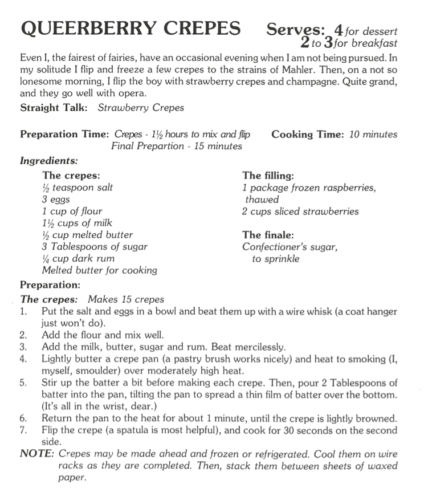
Michelle DuBarry’s “City Park Apple Tart” from But Can She Cook?
Any good meal must be topped off with a sweet treat. For dessert we have a recipe for a delectable apple tart from the legendary Canadian queen Michelle DuBarry.
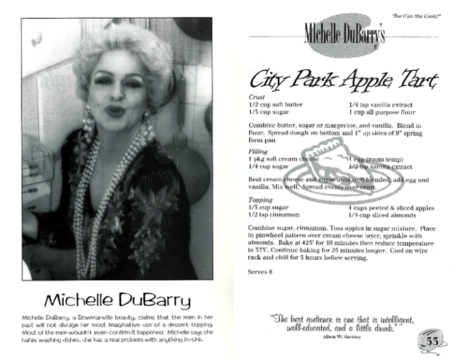
Bon Appétit!
That’s all we have on the menu today friends! Join us at The ArQuives to feast your eyes on the rest of our collection and visit us at arquives.ca for more information. You can sign-up for our newsletter and follow us on Facebook, Twitter, and Instagram, too, to follow along as we continue to preserve and tell the stories of LGBTQ2+ people in Canada.

